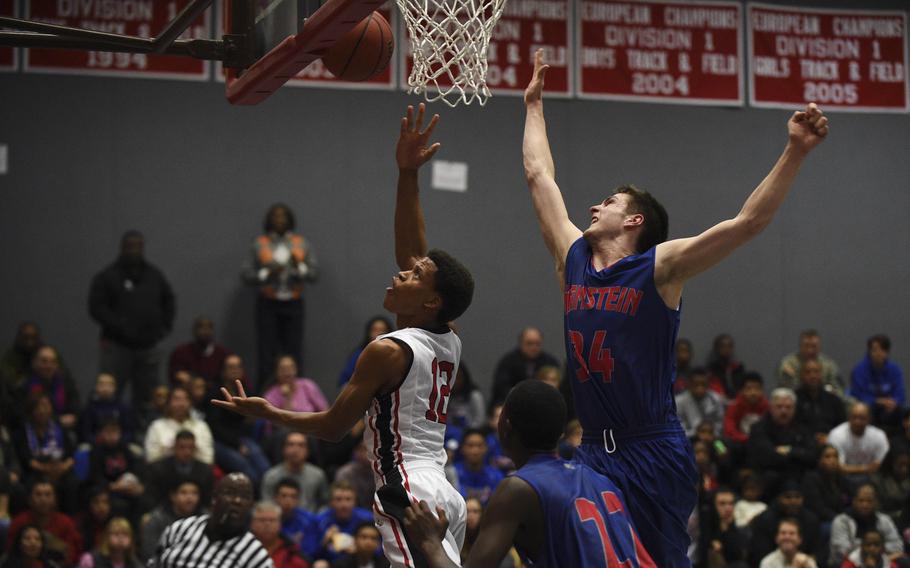
Kaiserslautern's Antwan Haynes gets a shot off as Ramstein's Jesse Gray challenges at Kaiserslautern, Germany, Jan. 27, 2015. (Joshua L. DeMotts/Stars and Stripes)
Coaches, and perhaps basketball coaches in particular, thrive on control. So imagine the frustration when the one factor that best predicts success lies outside of theirs.
“Hard-working, talented student-athletes equal success,” Wiesbaden girls basketball coach and athletic director Jim Campbell said. “These types of athletes can transfer in and out of your program overnight.”
Campbell’s comment neatly summarizes the plight of DODDS-Europe basketball coaches. Like a sand castle built too close to the water’s edge, their efforts at sustainable construction are always undermined by a process over which they have no influence.
There is an ideal template for a consistently competitive high-school basketball program. A healthy youth system imbues interested children in the community with basic skills and organized experience. Those kids move up to high school and join the junior varsity, where they further develop their skills and learn their school’s particular systems and strategies. When they’re ready, they’ll move up and contribute to the varsity squad, finding their way with the guidance of more-experienced older teammates. Eventually they’ll become elder role models themselves, helping the next wave of prospects find their way in the program.
In theory, that cycle could continue indefinitely.
But such a system assumes that most players will spend their entire school careers in one place, rising through the basketball ranks predictably and reliably. That’s an assumption DODDS-Europe coaches have learned never to make.
The transient nature of a military career means that many servicemembers and civilians - and the ball-playing dependents that accompany them on their tours – live in a near-constant state of flux, spending much of their lives either adjusting to a new place or preparing to leave it. While some parents might be able to exercise enough influence to extend their time at a certain base, the effects of a permanent change of station on a high-school basketball team do not factor into this ongoing churn.
That leaves DODDS-Europe basketball coaches at the mercy of what Sigonella girls coach and athletic director Michelle Chandler called the “PCS gods.” Sometimes coaches will reap a bountiful harvest of eager and talented ballplayers, perhaps even an unexpected superstar. Other seasons bring drought conditions, leaving depth charts bare of proven players.
“I would say experience is the most important factor (to team success), but there isn’t a team in Division I this season that was together last season,” Ramstein boys coach Andrew O’Connor said. “So you can throw that out the window.”
In response, DODDS-Europe coaches have learned to accept the significant role played by random chance in their programs’ fortunes. Since the situation is highly unlikely to change, many have developed work-arounds to maximize their team’s chances of success each year, regardless of the players they find on the first day’s practice court.
Lakenheath boys coach Alan Campbell said he emphasizes personal skill development and teamwork; the idea being that a lineup of equally-productive players would absorb any personnel losses better than a team overly reliant on a star or two.
“I avoid depending on one star player because the other players do not develop as they should,” the Lancers coach said. “I want my team to play as a team. I want each player on the floor to be effective defensively as well as a threat offensively.”
Hohenfels girls coach Shawn Rodman described a similar approach. Five of his 11 current varsity players have no prior organized experience, he said; part of his job is to put those players in positions to succeed without overextending them.
“We have to work on fundamentals and try to create situations where girls can perform the skills they do possess,” Rodman said. “As coaches, we have to make it work, or at least try to.”
There are other factors that further handcuff DODDS-Europe basketball coaches. At most DODDS-Europe schools, skilled athletes play multiple sports throughout the school year, bookending football or volleyball in the fall with baseball, softball or soccer in the spring. Basketball is wedged into the four months in between, with the added challenge of a month-long holiday break in which many student-athletes disappear for family vacations.
With the rotating cast of players, and those available splitting focus among a variety of sports and other extracurricular activities, it can be hard to find the practice time necessary to turn neophytes into serviceable players.
In that case, the problem is compounded. Such limitations would challenge even naturally gifted and experienced players, much less newcomers to the sport.
“You really need players who can come together and learn each other quickly.” AFNORTH boys coach Michael Gros said.
Vilseck boys coach John Sabala said he looks for players who are “disciplined and tough-minded” and unpreoccupied with individual glory.
“I believe the key to success is players buying into the program and believing in putting the team effort first in all things,” Sabala said. “That’s something that is very difficult with the players of this generation.”
Ultimately, the same realities that vex DODDS-Europe coaches give the sport a compelling brand of intrigue. A school’s hoops fortunes can swing wildly in any given season: a last-place team one year could dominate the next; a reigning champion might share nothing but a locker room and a uniform in common with the preceding team whose title they’re defending.
As for the coaches, they’ll just have to enjoy the ride.
“We have to develop our players to their potential,” Chandler said. “Different kids progress at different paces.
“It’s a pleasure to see just how much they develop by the end of the season.”
Twitter: @broomestripes